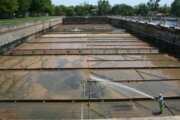Choosing new flooring is a serious pursuit, often fraught with uncertainty. The floors you choose, you’ll have to live with for a while, and could even affect your home’s resale value. Although wood floors are timeless, they can be a lot of work to maintain, leading some homeowners to seek alternatives.
An alternative wood floor might look an awful lot like a wood floor, but may lack other features like durability, or it might be a floor that looks nothing like a wood floor, but is long-lasting and dependable for years of heavy traffic, just like real wood.
How to Pick a New Floor
According to the professionals, before you even get too serious about patterns, you should be looking for a wood floor alternative that you can live with and love over the long term. Ultimately, you’ll be happier and bear a lot less stress from construction.
“Over time replacing floors is costly, time consuming and disruptive to your household,” says Sherry Krueger, co-owner of Creative Concrete Solutions LLC, in Wittmann, Arizona. “When making your decision to replace flooring in your home, consider longevity as well as the cost of all the flooring replacements over the course of decades.”
Choosing the perfect floor isn’t always something that happens overnight, but it’s a floor you’ll live with for a while, so it pays to take your time when selecting the wood alternative floor of your dreams. Almost any hard flooring can be considered a viable alternative to wood flooring, but if you want a true wood look, wood-look ceramic tiles, laminate flooring and luxury vinyl are among the top contenders.
[Read: How Much Hardwood Flooring Costs – And How to Save]
Alternative Flooring Costs
These are some common wood-alternative flooring types and how much they cost. Estimates are sourced from Angi and HomeAdvisor and include labor costs, except for ceramic tile, which only includes costs of materials.
— Luxury vinyl flooring: $2 to $10 per square foot
— Ceramic: $2 to $15 per square foot
— Laminate: $2 to $10 per square foot
— Cork: $6 to $10
— Bamboo: $7 to $20
— Concrete: $3 to $5
Luxury Vinyl Is a Versatile Option
Everybody is in love with luxury vinyl flooring right now, and for good reason. It’s a durable, easy-to-install and flexible option that can look like anything you want — whether you like the look of an old barn floor or prefer a more traditional oak flooring. Coming in at about $6 per square foot on average for materials and installation, according to home improvement network and information company Angi. Luxury vinyl is a high quality material with a reasonable price point.
“Currently my go-to solution to hardwood is luxury vinyl tiles (LVT),” says Michael Menn, architect and homebuilder in Northbrook, Illinois. “LVT is more forgiving. Most LVT is created with a foam backing so there is some give when walking across a room. The colors and patterns of LVT are so realistic that the majority of clients think it is real, natural wood. It’s also a unique product because it can be used to finish a basement, a laundry room, a kitchen or just about anywhere in a home. Its versatility is the main reason I specify and install it throughout a house.”
A wood alternative that can be consistently applied across your home is a great way to create a sense of continuity and consistency, but other materials like ceramic tile (regardless of whether or not it looks like hardwood) or laminate flooring can also fulfill this requirement.
Angi estimates the cost of LVTs at $2 to $10 per square foot.
Ceramic Tile Can Look Almost Like Wood
If you’re looking for a wood alternative that’s more durable and potentially more permanent than a luxury vinyl floor, ceramic tile offers a range of options. Regardless of how it looks, though, it can be pretty tough and last 75 to 100 years with proper installation, more or less on par with wood floors.
Standard ceramic tiles can cost anywhere from about $.50 to $7 per square foot indoors, and rectangular wood-look tile from $2 to $15 per square foot, according to Angi. Installation is extra and varies widely based on the amount of prep work that’s required ahead of the installation. For example, if there’s an old tile floor, it will have to be removed before a new one can go down.
Although it’s durable and can stand the test of time, ceramic floors (wood-look or otherwise) still require a fair amount of maintenance due to the grout lines between the tiles. These will need regular cleaning, resealing and sometimes replacement. When choosing ceramic floors, choose styles and colors that are timeless and grout lines that are less likely to show dirt, since you’ll likely be living with the floor for a while.
[READ: The Pros and Cons of Peel and Stick Tile.]
Laminate Flooring Is an Inexpensive Choice
Laminate flooring can be manufactured to look like almost anything, from wood flooring to marble tile and everything in between. But it’s not solid wood, and is instead made of a wood composite core with a Formica-like material on top. This creates a very durable and solid surface; check out any old countertop from the 1960s for evidence of how heavy-duty this material really is. You can buy it for under $2 per square foot for materials, according to Angi.
However, most laminate is not waterproof and will suffer or fail if installed in a wet room or a house with too high humidity. It’s also very slick, making it a poor choice in areas where falls are likely, or if you have pets or are simply a little more clumsy than you’d like to admit.
Adding enhancements (like scratch-resistant coating) will also increase costs, as does the wood pattern that the laminate mimics. Here’s how much laminate wood flooring costs by design, according to Angi.
| Design | Cost per square foot, including labor |
| Maple | $2-$6 |
| Red or white oak | $2-6 |
| Cherry | $3-$7 |
| Acaia | $3-$7 |
| Beech | $3-$7 |
| Walnut | $3-$7 |
| Hickory | $4-$10 |
| Source: Angi |
Cork Flooring Is a Renewable Material
Cork flooring is an interesting choice for someone looking for a wood flooring alternative. It’s made from the bark of trees that are carefully protected and harvested in a sustainable way to prevent damage to them. It can be a green option, but is somewhat costly, ranging from $3 to $12 per square foot for materials alone, or $5 to $14 on average when including labor according to HomeAdvisor
. Thickness, type and quality will impact the cost.
| Plank thickness (mm) | Average price per square foot (material only) | Average price per square foot including labor |
| 10 | $4-$5 | $6-$7 |
| 11 | $5-$6.50 | $7-$8 |
| 12 | $4-$8 | $6-$10 |
| Source: HomeAdvisor |
While it’s fairly easy to maintain, cork is still a soft material and won’t last as long as ceramic tile or wood flooring. It can be stained or scratched and may fail if improperly sealed or it doesn’t get resealed regularly. In addition, cork flooring is kind of an acquired taste and doesn’t necessarily have widespread appeal, which could be something to seriously consider if you’ll be selling your home in the near future.
Cork flooring is also available in luxury vinyl form and is less expensive than regular cork. Luxury vinyl cork flooring costs about $3 to $7 per square foot just for the materials and $5 to $9 when including labor, according to HomeAdvisor.
What About Other Green Wood Flooring Alternatives?
One of the biggest concerns for homeowners who are researching wood floor alternatives is whether other sustainable building materials can be as green as hardwood flooring. After all, some materials are simply not made to last and end up in landfills far too soon.
Bamboo
One popular sustainable flooring option is bamboo, which is often compared to wood flooring for environmental friendliness. You can expect to pay $7 to $20 per square foot for fully installed bamboo flooring, depending on the type you choose, according to HomeAdvisor.
“Wood flooring can last up to 75 years; bamboo looks great but it is relatively soft with a much shorter lifespan,” says Joshua Zinder, architect and managing partner at Joshua Zinder Architecture + Design in Princeton, New Jersey. “Since bamboo is a rapidly renewable resource, it could be considered to achieve a reasonable balance between competing objectives.”
Concrete
If your goal is sheer durability, concrete also presents a homeowner with endless green options. When it comes to flooring, “concrete definitely has the longest life span,” says Krueger. “To keep concrete flooring from needing to be remodeled I would recommend not choosing loud colors or designs. Instead, stay with very classic color palettes and subdued variations in pattern and hues.”
Concrete floors come with a wide range of color and design options, but can be as inexpensive as $3 to $5 per square foot, or as costly as $25 per square foot for large amounts of custom detail and hand finishing, according to Angi.
[READ: What Home Renovations Should You Make In a Recession?]
The Right Floor in the Right Room
Whatever you choose, it’s vital that you pick a flooring type that’s appropriate for the space where it will be installed. Different rooms and transitions in your home should have a floor that makes sense with how they’re going to be used.
“Kitchens need a floor that’s easy to clean and durable.” Zinder says, “while living rooms, dens and dining rooms want rich character and a softer feel.”
Special areas like staircases are tricky and can be dangerous if you choose the wrong wood alternative flooring for them. Although ceramic or porcelain tile and laminate flooring can look really nice, for example, they’re often dangerous options in these areas.
“When it comes to flooring and stairs, people should understand that stairs are one of the areas where falls occur most,” explains Menn. “You are stepping from one level to another, usually not looking down and where you are going. So, the solution should incorporate a surface that is not very slick. On the other hand, most stairs are decorative elements in the design of a residence, and you want to make them look awesome.”
If you’re hoping to ditch real wood floors for something that looks or acts the part, your best options include luxury vinyl, concrete and ceramic tile. Although styles change, these traditional materials have already proven they can stand the test of time.
More from U.S. News
15 Secrets to Selling Your Home Faster
How Much Hardwood Flooring Costs – And How to Save
What Are the Best Alternatives to Wood Flooring? originally appeared on usnews.com
Update 05/18/23: This story was published at an earlier date and has been updated with new information.







